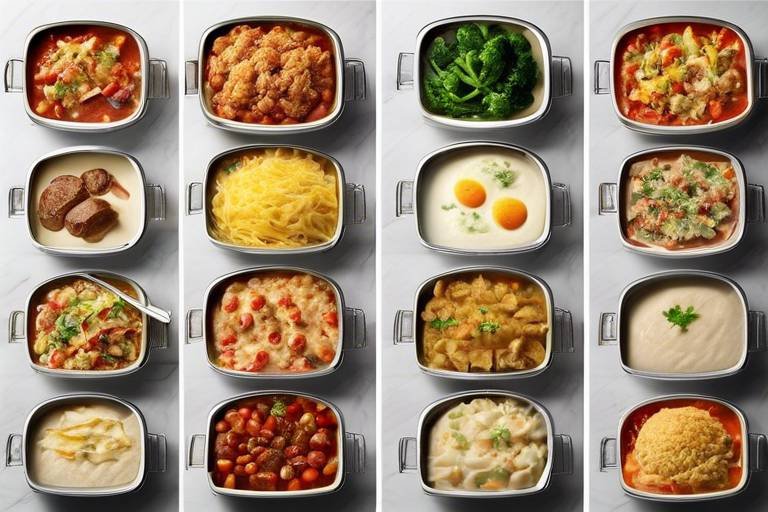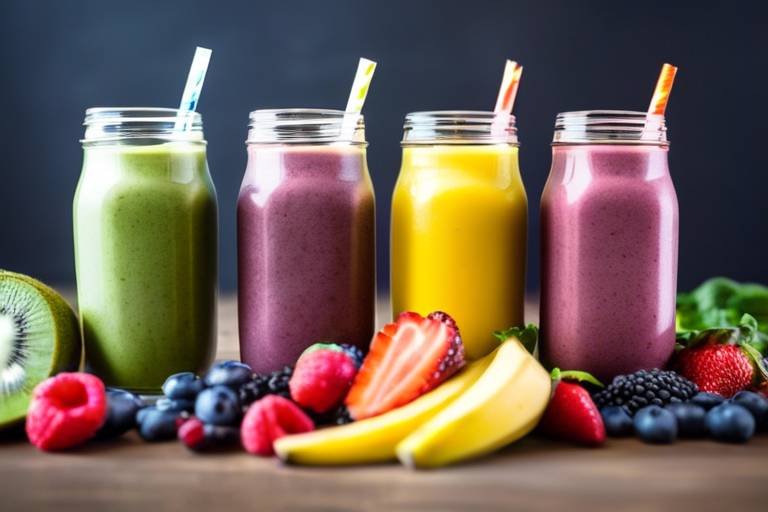Family Favorites: How to Make Classic Meals Nutrient Rich
When it comes to family meals, we all have those classic recipes that bring back warm memories, don't we? Whether it's mom's famous lasagna or grandma's hearty chicken soup, these dishes hold a special place in our hearts—and our stomachs! But what if I told you that you could elevate these beloved recipes by making them nutrient-rich without sacrificing their original flavors? That's right! By incorporating a few simple changes, you can transform your family favorites into meals that are not only delicious but also packed with essential nutrients. In this article, we’ll explore various strategies to enhance your classic meals, ensuring that everyone at the table enjoys a hearty serving of health along with their comfort food.
Nutrient density is a term that might sound fancy, but it’s really quite simple. It refers to the amount of essential nutrients—like vitamins, minerals, and fiber—per calorie in a food. Imagine two foods: one is a sugary snack that gives you a quick energy boost but leaves you feeling empty, while the other is a colorful salad brimming with nutrients. The salad is nutrient-dense, providing your body with what it needs to thrive without piling on empty calories. By choosing nutrient-dense ingredients, we can elevate our family meals and ensure that they are not just tasty but also beneficial for our health.
One of the easiest ways to boost the nutrition of your family favorites is by adding more vegetables. Not only do they increase the nutrient content, but they also add vibrant colors and textures to your dishes. Think about it: how can you make a classic spaghetti bolognese even better? By tossing in some finely chopped carrots, zucchini, or bell peppers! These veggies blend seamlessly into the sauce, enhancing the flavor while sneaking in extra vitamins and minerals. You can also try roasting vegetables as a side dish or including them in casseroles. The possibilities are endless!
Now, you might be wondering, "How can I replace less healthy ingredients without losing the taste I love?" Great question! Substituting ingredients is a game-changer. For instance, instead of using sour cream in your baked potatoes, try Greek yogurt. It’s creamy, tangy, and loaded with protein. Similarly, you can swap out white rice for quinoa or cauliflower rice. Not only do these alternatives boost the nutrient profile, but they also add new flavors and textures to your meals. Here’s a quick rundown of some simple substitutions:
| Traditional Ingredient | Nutritious Alternative |
|---|---|
| White rice | Quinoa or cauliflower rice |
| Sour cream | Greek yogurt |
| White pasta | Whole grain or lentil pasta |
| Butter | Avocado or olive oil |
Speaking of substitutions, let’s dive into the world of grains. Whole grains are a fantastic way to add fiber and essential nutrients to your meals. Think of whole grains as the superheroes of the grain world—they pack a punch of nutrients! By swapping out refined grains like white bread or pasta for whole grain options, you not only enhance the flavor but also keep your family feeling fuller longer. Whole grain pasta, brown rice, and whole wheat bread are all excellent choices that can easily replace their refined counterparts.
Don't shy away from fats! The key is to choose healthy fats that can enhance both flavor and nutrition. Adding ingredients like avocados, nuts, and olive oil can elevate your dishes while providing beneficial nutrients. For example, drizzling a bit of olive oil over roasted vegetables not only adds a rich flavor but also increases the absorption of fat-soluble vitamins. Plus, who doesn’t love the creamy goodness of avocado in a salad or on toast? It’s a win-win!
Did you know that the way you cook your food can affect its nutrient content? Some cooking methods can cause nutrients to break down, while others can help retain them. For instance, steaming vegetables is a fantastic way to keep their vibrant colors and nutrients intact. On the other hand, boiling can leach away essential vitamins. So, when preparing your family favorites, consider methods like roasting, grilling, or sautéing to preserve those precious nutrients. Your family will not only enjoy the taste but also benefit from the added health perks!
Now that we’ve covered nutrient density and ingredient substitutions, let’s talk about flavor! Boosting flavor while keeping meals healthy is crucial. After all, we want our family to enjoy their food, right? Using herbs, spices, and other natural flavor enhancers can make a world of difference. Instead of reaching for that salt shaker, experiment with fresh herbs like basil, cilantro, or parsley. Not only do they add a burst of flavor, but they also come with their own health benefits!
Herbs and spices are like the magic wands of the kitchen. They can transform a bland dish into something extraordinary! For instance, adding a sprinkle of cumin or paprika can give your hearty chili a delightful depth of flavor. Not to mention, many herbs and spices are packed with antioxidants and anti-inflammatory properties. So, the next time you’re cooking, don’t hesitate to get a little adventurous with your seasoning.
And let’s not forget about desserts! If you’re looking to sweeten things up, consider using natural sweeteners as healthier alternatives to refined sugars. Ingredients like honey, maple syrup, or mashed bananas can add sweetness without the guilt. Imagine a warm banana bread made with ripe bananas instead of sugar—delicious and nutritious!
Q: Can I still enjoy my favorite comfort foods while making them healthier?
A: Absolutely! By making simple substitutions and adding nutrient-dense ingredients, you can enjoy your favorite comfort foods without compromising on health.
Q: What are some easy ways to incorporate more vegetables into meals?
A: You can add vegetables to sauces, soups, and casseroles, or serve them as sides. Try blending them into smoothies or using them as pizza toppings for a fun twist!
Q: Are whole grains really better than refined grains?
A: Yes! Whole grains are packed with fiber and nutrients, which can help keep you full and satisfied while providing essential health benefits.

Understanding Nutrient Density
Nutrient density is a concept that every home cook should embrace, especially when aiming to create meals that are both delicious and healthy. But what exactly does it mean? In simple terms, nutrient density refers to the amount of essential nutrients—vitamins, minerals, and other beneficial compounds—contained in a food relative to its calorie content. This means that foods that are high in nutrients but low in calories are considered nutrient-dense, while those that are high in calories but low in nutrients are not.
Why is this important? Well, imagine you have a limited amount of calories to consume each day. Wouldn’t you want to make sure that every bite you take is packed with the nutrients your body craves? By focusing on nutrient-dense foods, you can ensure that your family is not just filling up their plates but also nourishing their bodies. For instance, a cup of spinach provides a wealth of vitamins A, C, and K, along with iron and calcium, all while being low in calories. In contrast, a sugary snack might give you a quick energy boost but lacks the essential nutrients your body needs.
To illustrate this concept further, let's take a look at a simple comparison:
| Food Item | Calories | Key Nutrients |
|---|---|---|
| Spinach | 7 | Vitamins A, C, K, Iron, Calcium |
| Potato Chips | 152 | Minimal Nutrients |
| Quinoa | 222 | Protein, Fiber, Magnesium |
| Chocolate Bar | 200 | Sugar, Fat (minimal nutrients) |
From the table above, it’s clear that while potato chips and chocolate bars may be tempting, they offer little in terms of nutritional value compared to foods like spinach and quinoa. By choosing nutrient-dense options, you can make a significant impact on your family’s health. This doesn't mean you have to eliminate all your favorite treats; instead, it’s about finding a balance and making smarter choices.
Incorporating nutrient-dense foods into your meals can be as easy as swapping out a few ingredients. For example, consider replacing white rice with quinoa or adding a variety of colorful vegetables to your pasta dishes. These small changes can lead to big health benefits over time, ensuring that your family is not only satisfied but also thriving.
Ultimately, understanding nutrient density is about making informed choices in the kitchen. It's about recognizing that food is not just fuel; it’s a source of nourishment that can enhance your family's overall well-being. So, the next time you’re planning a meal, ask yourself: Are the foods I’m choosing nutrient-dense? If not, how can I improve them?

Incorporating Vegetables
When it comes to family meals, the thought of sneaking in more vegetables can feel daunting. However, incorporating veggies into your classic dishes is not just a clever way to boost nutrition; it can also transform the flavor profile of your favorite meals. Imagine your beloved spaghetti bolognese, but with a colorful array of bell peppers, carrots, and spinach mixed in. Not only does this add a beautiful touch, but it also packs a nutrient punch that everyone at the table will appreciate.
One of the simplest ways to start is by adding finely chopped or grated vegetables into sauces and soups. For instance, when making a tomato sauce, consider adding shredded zucchini or carrots. These veggies blend seamlessly, enhancing the sauce's texture while providing essential vitamins and minerals. You might even find that your kids, who usually turn their noses up at greens, won’t even notice the extra veggies hidden in their plates!
Another fantastic method is to roast or sauté vegetables and serve them as a side dish. Think about roasting Brussels sprouts with a drizzle of olive oil and a sprinkle of sea salt. The roasting process caramelizes their natural sugars, creating a deliciously sweet and savory dish that pairs perfectly with any main course. Not only does this method bring out the best flavors, but it also encourages your family to enjoy a variety of vegetables in a fun and tasty way.
For those who love a good crunch, consider incorporating raw vegetables into your meals. A vibrant salad made with a mix of leafy greens, cherry tomatoes, cucumbers, and shredded carrots can serve as a refreshing side or even a main dish. To make it more enticing, add a homemade dressing using yogurt, lemon juice, and herbs, which not only enhances the taste but also adds probiotics and other beneficial nutrients.
Here are some creative ideas for incorporating vegetables:
- Blend Them In: Use a blender to create smoothies with spinach, kale, or even cauliflower. The sweetness of fruits like bananas or berries can mask the taste of the greens, making it a hit with kids.
- Top It Off: Add shredded veggies to your favorite pizza toppings. Caramelized onions, mushrooms, and spinach can elevate your pizza night while sneaking in those nutrients.
- Veggie Noodles: Swap out traditional pasta for spiralized zucchini or sweet potatoes. This not only adds fiber but also gives your dish a new twist.
Incorporating vegetables into your family’s meals is all about creativity and experimentation. The more you play around with flavors and textures, the more your family will embrace these healthy additions. Remember, it’s not just about making meals healthier; it’s about making them more exciting and enjoyable for everyone at the table!
Q: How can I get my kids to eat more vegetables?
A: Start by introducing vegetables in fun and creative ways. Use dips, blend them into smoothies, or incorporate them into their favorite dishes without making them the main focus.
Q: Are frozen vegetables as nutritious as fresh ones?
A: Yes! Frozen vegetables are often picked at peak ripeness and flash-frozen, preserving their nutrients. They can be just as nutritious as fresh ones, making them a convenient option.
Q: What are some easy vegetables to incorporate into meals?
A: Some easy options include spinach, carrots, bell peppers, zucchini, and broccoli. These can be added to sauces, soups, salads, and stir-fries.

Substituting Ingredients
When it comes to making our beloved family recipes healthier, one of the most effective strategies is . This doesn't mean we have to compromise on flavor; in fact, it can enhance our dishes in surprising ways. Think of it like a secret ingredient that not only boosts nutrition but also adds a new twist to familiar favorites. For instance, instead of using regular pasta, consider swapping it for whole grain or even vegetable-based alternatives. Not only do these options provide more fiber, but they also offer a unique taste and texture that can elevate your meal.
Another great substitution is to replace sour cream with Greek yogurt. This switch not only reduces calories but also packs in protein and probiotics, making your dish a powerhouse of nutrition. Likewise, using low-sodium broth instead of regular broth can cut down on sodium intake, which is particularly important for those watching their salt levels. It's all about being creative and thinking outside the box!
Here are some common ingredient substitutions that can make your meals healthier without sacrificing taste:
- White sugar: Swap for honey, maple syrup, or coconut sugar for a more natural sweetness.
- Butter: Try using avocado or applesauce in baking to reduce saturated fat.
- Regular cheese: Opt for reduced-fat cheese or nutritional yeast for a cheesy flavor with fewer calories.
- Ground beef: Substitute with ground turkey or lentils for a leaner protein option.
It's important to remember that not all substitutions will work perfectly in every recipe, so a little experimentation may be necessary. For example, if you're baking, the moisture content can change with different fats, so adjusting your other ingredients may be required. But don't be discouraged! Each attempt is a step towards creating a healthier, nutrient-rich meal that your family will love.
Ultimately, the goal of ingredient substitution is to maintain the essence of the dish while enhancing its nutritional profile. With a bit of creativity and willingness to experiment, you can transform classic recipes into modern, health-conscious meals that everyone at the table will enjoy. So, next time you're in the kitchen, think about how you can swap out a few ingredients to make your family's favorites even better!
Q: Can I substitute all ingredients in a recipe?
A: While many ingredients can be substituted, it's important to consider how these changes will affect the overall flavor and texture of the dish. Some ingredients work better as substitutes than others, so start with small changes and adjust as needed.
Q: Will my family notice the difference?
A: They might! But often, if the substitutions are done thoughtfully, they'll be pleasantly surprised by the new flavors and textures. You might even discover new family favorites!
Q: Are there any substitutions that should be avoided?
A: Some substitutions may not work well, especially in baking where precise measurements and ingredient properties are crucial. For example, substituting baking soda for baking powder can lead to disappointing results.
Q: How do I know if a substitution is healthier?
A: Generally, look for options that offer more nutrients (like fiber and protein) and fewer unhealthy fats and sugars. Researching the nutritional content of different ingredients can help guide your choices.

Whole Grains vs. Refined Grains
When it comes to choosing the right grains for your family's meals, understanding the difference between whole grains and refined grains is crucial. Whole grains are grains that have not been stripped of their nutrient-rich bran and germ during processing. This means they retain essential nutrients such as fiber, vitamins, and minerals. On the other hand, refined grains have undergone processing that removes these parts, leading to a loss of nutrients and fiber. Think of whole grains as the complete package, while refined grains are like a book missing half its chapters.
One of the standout benefits of whole grains is their ability to keep you feeling full longer, thanks to their high fiber content. This can be a game changer for families looking to manage weight or simply eat healthier. For instance, switching from white rice to brown rice or from regular pasta to whole wheat pasta can provide a satisfying meal that also nourishes the body. Not only do whole grains offer more nutrients, but they also contribute to better digestion and can help reduce the risk of chronic diseases.
Now, let's take a look at a quick comparison between whole grains and refined grains:
| Aspect | Whole Grains | Refined Grains |
|---|---|---|
| Nutritional Value | High in fiber, vitamins, and minerals | Lower in nutrients, often enriched |
| Fiber Content | High | Low |
| Satiety | Helps keep you full | May lead to hunger sooner |
| Examples | Brown rice, quinoa, whole wheat bread | White rice, white bread, regular pasta |
Incorporating whole grains into your family's diet can be as simple as making small changes. For example, consider using whole grain flour in your baking, or opt for whole grain cereals for breakfast. These subtle shifts not only enhance the nutritional profile of your meals but also introduce your family to a variety of flavors and textures. Remember, it’s not just about swapping one ingredient for another; it’s about enriching your meals and making them more satisfying and nutritious.
So, the next time you’re planning dinner or whipping up a batch of cookies, think about the grains you’re using. Choosing whole grains is a delicious way to boost the health of your family while still enjoying the meals they love. After all, who wouldn’t want a little extra goodness in their favorite recipes?
- What are some easy ways to incorporate whole grains into my diet?
Start by swapping out white rice for brown rice, using whole grain bread instead of white bread, and trying whole grain pasta. You can also add quinoa or bulgur to salads and soups for an extra nutrient boost.
- Are refined grains completely unhealthy?
While refined grains are lower in nutrients compared to whole grains, they can still be part of a balanced diet. However, it’s best to limit their intake and focus on whole grains for the majority of your grain consumption.
- How can I make my family more accepting of whole grains?
Start by introducing whole grains gradually. Mix whole grain products with refined ones until your family gets used to the taste and texture. You can also experiment with different recipes that highlight the flavors of whole grains.

Healthy Fats
When it comes to enhancing the nutritional profile of our family meals, play a crucial role. Often misunderstood and unfairly demonized in the past, fats are essential for our bodies, providing energy, supporting cell growth, and aiding in the absorption of vital nutrients. Imagine fats as the unsung heroes of our diets; they not only help our meals taste richer and more satisfying but also contribute to overall health when chosen wisely.
But what exactly are healthy fats? They primarily come from plant sources and fish, and include options like avocados, nuts, seeds, and olive oil. These fats are packed with omega-3 and omega-6 fatty acids, which are essential for brain function and heart health. Incorporating these into your favorite family recipes can transform a simple dish into a nutrient powerhouse. For instance, drizzling olive oil over roasted vegetables not only enhances their flavor but also adds a dose of healthy monounsaturated fats that can help lower bad cholesterol levels.
One of the best ways to introduce healthy fats into your meals is by swapping out less nutritious fats, such as butter or margarine, with these beneficial alternatives. Instead of butter on your morning toast, try spreading avocado or using a nut butter. Not only will this keep your meal creamy and delicious, but it will also add fiber and essential fatty acids that are great for heart health.
Furthermore, incorporating fatty fish like salmon or mackerel into your weekly dinner rotation can be a game-changer. These fish are not only delicious but are also loaded with omega-3 fatty acids, which have been shown to reduce inflammation and promote heart health. Consider grilling salmon and serving it with a side of quinoa and steamed broccoli for a meal that’s not just tasty but also brimming with nutrients.
In addition to these options, nuts and seeds are fantastic sources of healthy fats. They can be tossed into salads, blended into smoothies, or even used as a crunchy topping for your favorite dishes. For example, sprinkling some chia seeds on your yogurt or oatmeal not only adds a delightful crunch but also boosts the meal’s nutrient density with fiber, protein, and healthy fats.
To wrap it up, embracing healthy fats in your family meals is not just about making a dish taste better; it’s about enriching it with nutrients that support overall health. So, the next time you’re in the kitchen, think about how you can creatively incorporate these healthy fats into your beloved recipes. Remember, it’s all about balance and making smart choices that benefit both your taste buds and your body!
- What are some examples of healthy fats? Healthy fats include avocados, nuts, seeds, olive oil, and fatty fish like salmon.
- Can I still eat saturated fats? While it's okay to include some saturated fats in your diet, it's best to limit them and focus on unsaturated fats for better health.
- How can I incorporate healthy fats into my meals? You can add healthy fats by using olive oil in dressings, adding nuts to salads, or including fatty fish in your weekly meal plan.

Cooking Methods that Preserve Nutrients
When it comes to cooking, the methods you choose can significantly impact the nutrient content of your meals. Imagine spending hours preparing a delicious family dinner, only to realize that a few simple mistakes have stripped your vegetables of their vibrant colors and essential vitamins. To keep those nutrients intact, it's crucial to adopt cooking techniques that are gentle yet effective. So, let’s dive into some of the best methods to preserve the goodness in your food.
One of the most effective methods is steaming. This technique allows vegetables to cook quickly while retaining their natural flavors and nutrients. By using steam instead of boiling water, you can avoid leaching vital nutrients away. For instance, broccoli steamed for just a few minutes can retain up to 90% of its vitamin C content, compared to only 60% when boiled. If you don’t have a steamer, a simple colander over a pot of boiling water works just as well!
Another great option is sautéing with a splash of healthy oil. This cooking method involves cooking food quickly over high heat, which helps to lock in flavors and nutrients. Using oils like olive or avocado oil not only adds a delightful taste but also provides healthy fats that can enhance nutrient absorption. Just remember to keep the heat at a moderate level to prevent burning the oil, which can create harmful compounds and diminish the health benefits.
Next up is roasting, a fantastic way to bring out the natural sweetness in vegetables. Roasting at high temperatures caramelizes the sugars in vegetables, creating a rich flavor profile without the need for excessive seasoning. This method is particularly great for root vegetables like carrots and sweet potatoes. To maximize nutrient retention, try roasting them with their skins on, as many nutrients are concentrated just beneath the surface.
Let’s not forget about microwaving, which often gets a bad rap. When used correctly, microwaving can be a quick and effective way to preserve nutrients. The key is to use minimal water and short cooking times. In fact, studies have shown that microwaving vegetables can retain more nutrients than boiling or frying. Just place your veggies in a microwave-safe dish with a lid, add a splash of water, and zap them for a few minutes. It’s that easy!
Finally, consider raw preparations for certain vegetables. Eating them raw can sometimes be the best way to enjoy their full nutritional benefits. Think of salads loaded with fresh greens, tomatoes, and peppers. Not only do they provide a crunchy texture, but they are also packed with vitamins and enzymes that can be lost during cooking. Pair them with a light dressing made from olive oil and vinegar to enhance flavor without sacrificing health.
In summary, the way you cook can make a world of difference in the nutritional value of your meals. By opting for methods like steaming, sautéing, roasting, microwaving, and enjoying raw preparations, you can create delicious dishes that are not only family favorites but also nutrient-rich. So, the next time you’re in the kitchen, think about how you can preserve those vital nutrients while still delivering mouthwatering flavors!
- What is the best cooking method for preserving nutrients? Steaming is often considered the best method for preserving nutrients, as it minimizes nutrient loss.
- Can microwaving vegetables destroy their nutrients? Not necessarily! When done correctly, microwaving can actually retain more nutrients compared to boiling.
- Are there any vegetables that should always be cooked? Some vegetables, like tomatoes and carrots, can benefit from cooking as it can increase the availability of certain nutrients.

Flavor Enhancements
When it comes to making meals both delicious and nutritious, flavor enhancements are your secret weapon. Imagine biting into a dish that not only satisfies your taste buds but also fuels your body with essential nutrients. It's all about finding that sweet spot where flavor meets health, and trust me, it’s easier than you think! The key is to embrace the natural flavors of high-quality ingredients, and one of the best ways to do this is by using herbs and spices. These little powerhouses can transform your family favorites into culinary masterpieces while boosting their nutritional profile.
Herbs and spices are nature's way of adding pizzazz to your meals. They not only enhance the taste but also come packed with health benefits. For instance, garlic and ginger aren't just aromatic; they have anti-inflammatory properties. Similarly, herbs like basil and parsley can elevate a dish while providing vitamins and antioxidants. So, why not sprinkle a bit of fresh basil on your pasta or add a dash of turmeric to your stews? Your taste buds and your body will thank you!
But let’s not stop there! Natural sweeteners are another fantastic way to enhance flavor without compromising health. Instead of reaching for that refined sugar, consider options like honey, maple syrup, or even mashed bananas. These alternatives not only add sweetness but also introduce a range of nutrients. For example, honey is rich in antioxidants, while bananas provide potassium and fiber. Imagine whipping up a batch of your favorite cookies using mashed bananas instead of sugar; the result is a moist, flavorful treat that’s also guilt-free!
To give you an idea of how these flavor enhancers can be used, here’s a simple table showcasing some common herbs, spices, and natural sweeteners along with their benefits:
| Ingredient | Flavor Profile | Health Benefits |
|---|---|---|
| Garlic | Pungent, savory | Anti-inflammatory, heart health |
| Turmeric | Earthy, slightly bitter | Anti-inflammatory, antioxidant |
| Basil | Sweet, aromatic | Rich in vitamins A and K |
| Honey | Sweet, floral | Rich in antioxidants, antibacterial properties |
| Maple Syrup | Sweet, caramel-like | Contains minerals like manganese and zinc |
Incorporating these ingredients into your family meals can be a game-changer. Not only do they enhance flavor, but they also add a burst of nutrients that can elevate your health. So next time you're cooking, think about how you can swap out those bland, processed ingredients for vibrant herbs and spices. Your dishes will not only taste better but will also be a lot healthier!
As you embark on this flavorful journey, remember that cooking is an art. Feel free to experiment! Mix and match different herbs and spices to find what your family loves best. Maybe a pinch of cumin in your chili or a sprinkle of cinnamon in your oatmeal could be the twist you’ve been looking for. The possibilities are endless!
- What are the best herbs to start with? Fresh basil, parsley, and cilantro are great options for beginners!
- Can I use dried herbs instead of fresh? Absolutely! Just remember that dried herbs are more potent, so use about one-third of the amount.
- How can I incorporate more spices into my meals? Start by adding a small amount to your favorite dishes, and gradually increase the quantity as you get used to the flavors.

Herbs and Spices
When it comes to elevating the flavor of your family’s favorite meals, herbs and spices are your secret weapons. Not only do they add zest and aroma, but they also pack a nutritional punch that can transform a simple dish into a health-boosting feast. Think of herbs and spices as the fairy dust of the culinary world; just a sprinkle can turn the mundane into the magical! For instance, adding fresh basil to a classic tomato sauce not only enhances its flavor but also introduces a host of vitamins and antioxidants.
Let’s break it down a bit more. Many common herbs and spices are not just flavor enhancers; they also come with impressive health benefits. For example, turmeric, a vibrant yellow spice, is renowned for its anti-inflammatory properties and can be easily incorporated into soups, stews, or even rice dishes. Similarly, cinnamon, often associated with sweet treats, can help regulate blood sugar levels and add a warm, comforting flavor to oatmeal or smoothies. By incorporating these ingredients into your meals, you’re not just seasoning your food; you’re also boosting its nutrient profile.
It’s also worth noting that herbs and spices can play a role in reducing the need for added salt and sugar in your cooking. Many people are unaware that excessive salt and sugar can lead to health issues over time. By seasoning your dishes with flavorful herbs like rosemary, thyme, or cilantro, you can achieve a satisfying taste without compromising your family's health. The beauty of using herbs and spices is that they allow you to explore different cuisines and flavors, keeping mealtime exciting and enjoyable.
Here’s a quick overview of some popular herbs and spices, along with their benefits:
| Herb/Spice | Benefits |
|---|---|
| Basil | Rich in antioxidants and anti-inflammatory properties. |
| Turmeric | Contains curcumin, known for its anti-inflammatory and antioxidant effects. |
| Cinnamon | Helps regulate blood sugar and adds a sweet flavor without sugar. |
| Ginger | Supports digestion and has anti-nausea properties. |
| Oregano | High in antioxidants and may help fight bacteria. |
Incorporating herbs and spices into your cooking is not only a way to enhance flavor but also a means to create healthier meals that your family will love. So, next time you’re whipping up a classic recipe, think about how you can sprinkle in some extra flavor and nutrition. It’s a simple change that can make a big difference in the health and happiness of your family!
Q: How can I store fresh herbs to keep them longer?
A: Fresh herbs can be stored in a glass of water in the fridge, covered loosely with a plastic bag. Alternatively, you can chop them and freeze them in ice cube trays with a bit of olive oil.
Q: Are dried herbs as effective as fresh herbs?
A: Dried herbs are more concentrated in flavor, so you typically need less than you would with fresh herbs. However, fresh herbs often provide more vibrant flavor and nutrients.
Q: Can I use spices that are past their expiration date?
A: While spices may not be harmful after their expiration date, they can lose their potency and flavor. It’s best to replace them periodically for the best taste.

Natural Sweeteners
When it comes to sweetening our favorite desserts, many of us are on the lookout for alternatives that are not only delicious but also healthier. Enter natural sweeteners! These delightful substitutes can elevate your dishes while keeping your health in check. Imagine swapping out refined sugar for something that not only tastes good but also offers additional nutrients. It's like finding a hidden gem in your kitchen!
Natural sweeteners come in various forms, each with its unique flavor profile and health benefits. For instance, honey is a classic choice that not only adds sweetness but also boasts antibacterial properties. Similarly, maple syrup provides a rich, caramel-like flavor and is packed with antioxidants. Then there's agave nectar, which is sweeter than sugar but has a lower glycemic index, making it a popular choice for those watching their blood sugar levels.
But, how do you incorporate these sweeteners into your family’s favorite recipes? The beauty is in the versatility! You can use them in baking, drizzling over pancakes, or even mixing into smoothies. For example, if you're making a batch of oatmeal cookies, try using mashed bananas or applesauce as a natural sweetener. Not only do they add sweetness, but they also contribute moisture and nutrients, making your cookies a bit more wholesome.
Here’s a quick comparison of some popular natural sweeteners:
| Sweetener | Flavor Profile | Health Benefits |
|---|---|---|
| Honey | Floral, rich | Antibacterial, antioxidant |
| Maple Syrup | Caramel-like | Rich in minerals, antioxidant |
| Agave Nectar | Mild, neutral | Low glycemic index |
| Coconut Sugar | Caramel-like | Contains minerals, lower fructose |
It’s essential to remember that while natural sweeteners can be healthier, moderation is still key. Just because something is labeled "natural" doesn’t mean it’s free from calories. Think of it like a delicious piece of cake: it can be a delightful treat, but having it every day might not be the best idea for your waistline or your health. Balance is the name of the game!
In conclusion, natural sweeteners are a fantastic way to maintain the sweetness in your family’s favorite recipes while adding a touch of nutrition. They allow you to enjoy the flavors you love without compromising on health. So, the next time you’re whipping up a dessert, consider reaching for one of these natural alternatives. Your taste buds—and your body—will thank you!
- What are natural sweeteners? Natural sweeteners are sugar alternatives derived from natural sources such as plants, fruits, and honey.
- Are natural sweeteners healthier than refined sugar? Generally, yes! Many natural sweeteners offer additional nutrients and have a lower glycemic index compared to refined sugar.
- Can I use natural sweeteners in baking? Absolutely! You can substitute natural sweeteners in most recipes, but you may need to adjust the liquid content based on the sweetener's consistency.
- How do I choose the right natural sweetener? It depends on the flavor profile you’re looking for and any dietary considerations. Experimenting with different options can help you find your favorite!
Frequently Asked Questions
- What is nutrient density and why is it important?
Nutrient density refers to the amount of essential nutrients a food contains relative to its calorie content. Choosing nutrient-dense foods is crucial because it helps ensure that your family gets the vitamins and minerals they need without consuming excess calories. Think of it as getting the most bang for your buck when it comes to nutrition!
- How can I incorporate more vegetables into my family meals?
Incorporating vegetables can be as simple as adding them to your favorite dishes. You can sneak spinach into lasagna, toss some bell peppers into stir-fries, or even blend veggies into smoothies. The key is to get creative and think outside the box—your family might not even notice those extra greens!
- What are some healthy ingredient substitutions I can make?
Swapping out less healthy ingredients for more nutritious options is easier than you think! For example, use Greek yogurt instead of sour cream, or replace white rice with quinoa. These little changes can significantly boost the nutrient profile of your meals while keeping them delicious.
- Why should I choose whole grains over refined grains?
Whole grains are packed with fiber and nutrients that refined grains lack. They help with digestion and keep you feeling full longer. By choosing whole grains like brown rice or whole wheat pasta, you're adding a nutritious punch to your meals without changing the flavors your family loves.
- What are some examples of healthy fats I can use in cooking?
Healthy fats, such as those found in avocados, nuts, and olive oil, are great for enhancing flavor and nutrition in your meals. They provide essential fatty acids that your body needs to function properly. So, don’t shy away from adding a drizzle of olive oil to your salads or mashing up some avocado on toast!
- How can cooking methods affect nutrient retention?
The way you cook your food can significantly impact its nutrient content. Methods like steaming or sautéing can help preserve vitamins and minerals better than boiling, which can leach nutrients into the water. So, next time you’re in the kitchen, consider how your cooking methods can help keep your meals as nutritious as possible!
- What are some natural ways to enhance flavor in healthy dishes?
Herbs and spices are your best friends when it comes to boosting flavor without adding calories. Fresh basil, garlic, or even a sprinkle of chili flakes can transform a bland dish into a culinary delight. Plus, many herbs and spices offer health benefits, making them a win-win for your family meals!
- Are there healthier alternatives to refined sugars for sweetening desserts?
Absolutely! Natural sweeteners like honey, maple syrup, or even mashed bananas can add sweetness to your desserts without the drawbacks of refined sugars. They often come with additional nutrients and can enhance the flavor profile of your treats, making them both delicious and healthier.



















